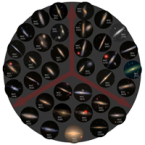CHANG-ES (Continuum Halos in Nearby Galaxies — an EVLA Survey) is a large project to observe 35 edge-on galaxies using the Expanded Very Large Array (EVLA, now known as the Karl G. Jansky Very Large Array) at two frequencies: 6 GHz (C-band) and 1.6 GHz (L-band). Click here to see our membership.
The observations have been carried out at B, C, and D configurations in L-band and at C and D configurations in C-band. All polarization products have been obtained which provide maps of total intensity, linear polarization, and polarization angle. Since the bandwidths are large (500 MHz and 2 GHz at L-band and C-band, respectively), it is also possible to form maps of the spectral index at each band. Together, these data form the most comprehensive data set yet available for the study of nearby edge-on galaxies. Complementary Green Bank Telescope (GBT) observations currently in progress will provide information on the large scale halo emission to complete the project. Note that this website applies to VLA data only.
Our scientific goals encompass a variety of objectives involving galaxy disks, disk-halo outflows, and broader-scale halos. These include:
- understanding the physics of outflowing gas
- mapping vertical structures and seeing how they may relate to in-disk star formation or magnetic field strength and direction
- determining the infra-red/radio continuum relation as a function of position
- separating thermal from non-thermal emission
- following cosmic ray transport
- correlating the observed continuum features with known lagging halos
- isolating active galactic nuclei, where present
These results can be compared to complementary data at other wavebands so that a global and comprehensive understanding of galaxy outflows may result.
Acknowledgement
The CHANGE-ES web pages are hosted by the CANFAR platform using hardware provided by the Digital Research Alliance of Canada.
